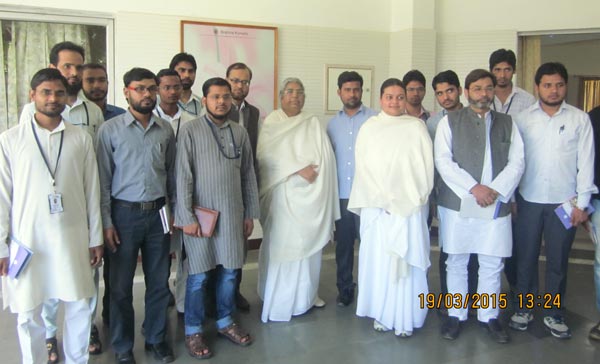The students of Islami Academy, New Delhi left the Academy campus for the Om Shanti Retreat Centre, Gurgaon, a branch of ‘Brahma Kumaris’ school of neo-spiritual movement on 19 March 2015. The movement was started by Lekhraj Khubchand Kripalani (15 December 1876 – 18 January 1969) also known as Dada Lekhraj in Hyderabad, Sindh, Pakistan in 1936. This educational tour was the part of our course, Islamic Thoughts and Studies. Our purpose was to understand the basic thoughts and methodologies and also the impact of the neo-spiritual movement on the common people.
After two hours and a half journey we reached the destination. Two volunteers received us from the main gate of the campus. After having been served light refreshment, we were ushered in a hall. In a while, a young bright lady wearing a white saree in a particular saintly style appeared in the hall. Before addressing us, she introduced herself as Husain, an MBA and Muslim by birth.
“After the partition, the headquarters of Brahma Kumaris was shifted to Mount Abu, Rajasthan in 1950,” she said while explaining the characteristics and significance of the ‘Soul’ in human life and necessity of meditation. The Om Shanti Centre has more than 8,500 centres in over 135 countries. And it also works in 19 different sectors of society. “Human beings strive for material prosperity but they cannot achieve inner peace and satisfaction. In such a situation men can find this type of retreat centre to regain their spiritual happiness,” she informed us.
They identified the disease of the soul. But their treatment methodology takes most of the remedies from the Vedic myth and philosophy with a moderate and humanist explanation. The ‘Spiritual Art Gallery’ has been established for this purpose and there are many idols of Hindu gods and goddesses, of course with new explanations.
We also performed meditation for two munities under her guidance. One may explain this Vedic philosophy and myth based spiritual movement as ‘the old wine in a new bottle with a moderate seal, humanist packaging and missionary advertisement’. These types of movements suggest that humanity is groping in the dark for spiritual salvation. The field is vast and open. Whether there is anybody who can stand up to provide this spiritual help is the question.


